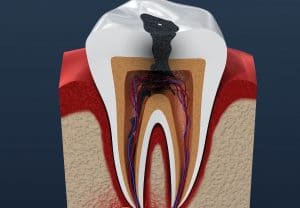 When your tooth is compromised for any reason, how your dentist restores it depends on several different factors. For example, if your tooth develops a case of decay, which can lead to the formation of a cavity in the tooth’s structure, then treating it early could mean restoring the tooth with a tooth-colored filling. However, if the decay is serious and has reached the tooth’s pulp and root canal, then root canal treatment may be the appropriate solution for it. Today, we take a closer look at root canal treatment, including the infection that warrants it and how it can save your smile from even more complications.
When your tooth is compromised for any reason, how your dentist restores it depends on several different factors. For example, if your tooth develops a case of decay, which can lead to the formation of a cavity in the tooth’s structure, then treating it early could mean restoring the tooth with a tooth-colored filling. However, if the decay is serious and has reached the tooth’s pulp and root canal, then root canal treatment may be the appropriate solution for it. Today, we take a closer look at root canal treatment, including the infection that warrants it and how it can save your smile from even more complications.
When is root canal treatment recommended?
While tooth decay is the most common chronic oral health concern for adults, root canal therapy isn’t the usual recommended treatment for it. When tooth decay first develops, it’s most notable for the cavity that forms in your tooth’s main structure. Not only because of the discomfort that the cavity causes, but also because tooth decay is most often treated at this stage, before it has a chance to progress to the tooth’s inner chambers. Root canal treatment is only recommended when this intrusion occurs, as the procedure is necessary to successfully remove all traces of infection from within the tooth’s natural structure.
What does the procedure accomplish for your tooth?
When you receive root canal therapy to treat a severely infected tooth, the advantages are significant, especially for your long-term oral health. Internal tooth infection involves the infection of the tooth’s nerves, blood vessels, and other soft tissues, which reside inside of the pulp chamber at the center of the tooth. This chamber connects to the root canal, which allows the tooth’s tissues to connect to the jawbone structure. Root canal therapy involves removing the infected tissues from these chambers, then sealing them to protect the tooth from further infection by harmful oral bacteria.
What’s in store for the tooth’s future?
After receiving root canal therapy, the threat of infection can be successfully removed from the tooth and its surrounding oral structures. However, the structure and tissues that have been removed the tooth can also leave it weaker, and more vulnerable to suffering structural damage in the future. To prevent this, we may suggest placing a dental crown over the tooth after root canal treatment is performed.
Learn more about root canal treatment
Find out if your tooth needs root canal treatment, and how it can help you restore and preserve your oral health. To learn more, schedule a consultation by calling the Dental Centre of Conroe in Conroe, TX, today at (936) 441-4600. We serve patients from Conroe and all neighboring communities.


